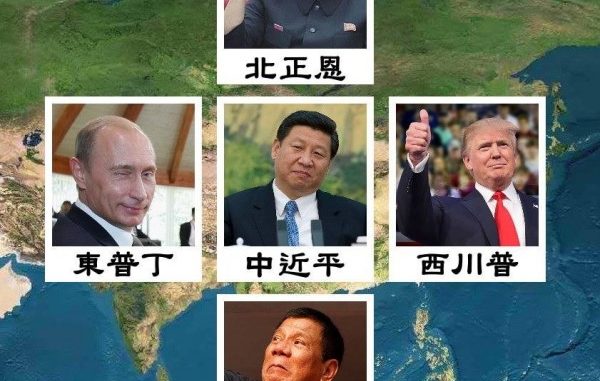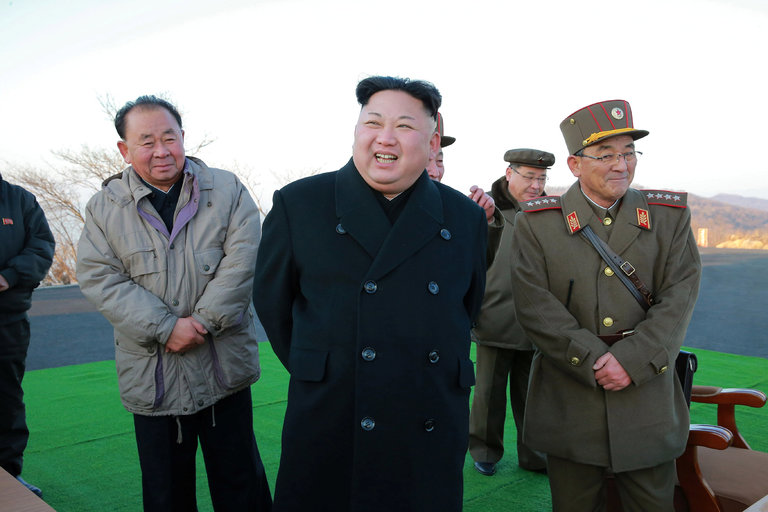
Missile test likely to intensify differences between Trump and Xi over how to deal with recalcitrant North Korea regime. Timing a deep embarrassment for Xi as leader of China, which for decades has been the North’s closest ally. China accounts for about 90% of the North’s trade and is a major supplier of oil for the country. But in DC eyes, China too reluctant to use economic leverage forcibly enough to stop North’s growing nuclear and missile threats – US continuing to ignore Beijing’s well-founded fear of millions of ill-educated / hungry / poor refugees streaming to China if Kim regime collapses. Top, visual representation of the intense political / military / economic cross-currents in East Asia. Below, Kim Jong-un, North Korea’s leader, in Pyongyang in March. A missile took off from Sinpo, a town on North Korea’s east coast, and flew 37 miles before splashing into the sea.
North Korea fired a ballistic missile off its east coast on Wednesday,
a day before President Trump was to host his Chinese counterpart, President Xi Jinping,
at his Mar-a-Lago estate in Florida for their first summit meeting.
The missile test is likely to intensify differences between Trump and.Xi over how to deal with the recalcitrant government in North Korea.
The timing is also a deep embarrassment for. Xi as the leader of China, which for decades has been the North’s closest ally.
China accounts for about 90% of the North’s trade and is a major supplier of oil for the country.
But in the eyes of Washington, China has been reluctant to use its economic leverage forcibly enough to stop the North’s growing nuclear and missile threats.
There was no immediate reaction from state news media in China.
Xi was in Finland when the test was carried out.
In Seoul, the South Korean capital, acting President Hwang Kyo-ahn ordered
a meeting of security cabinet ministers to assess the test and the North’s growing missile menace.
The missile took off from Sinpo, a town on North Korea’s east coast, and flew 37 miles before splashing into the sea,
the South Korean military said in a statement.
Initial assessments indicated that the type of missile was a KN-15,
said Cmdr. David Benham of the Navy, a spokesman for the US Pacific Command.
KN-15 is the name the US uses to refer to the Pukguksong-2,
a new nuclear-capable intermediate-range ballistic missile North Korea launched for the first time in February.
The February missile test took place while Trump was hosting Prime Minister Shinzo Abe of Japan at his Mar-a-Lago club.
“The North American Aerospace Defense Command determined the missile launch from North Korea did not pose a threat to North America,”
Benham said, referring to the missile launched on Wednesday.
It was the first test from North Korea since a launch on March 22.
That test was considered a failure, with the projectile exploding within seconds of launching,
according to American and South Korean defense authorities.
But by launching a missile on Wednesday, North Korea apparently sought to pull attention to its growing missile and nuclear weapons threats a day before the United States-China summit meeting.
To Trump, the test is a new reminder that North Korea’s leader, Kim Jong-un, is determined to develop a long-range missile that can one day carry a nuclear warhead across the Pacific.
Before the summit meeting, Trump increased pressure on China, saying that it was time for Beijing to rein in its Communist ally.
In an interview with The Financial Times published on Sunday, he said,
“If China is not going to solve North Korea, we will.”
But he did not say how — undoubtedly because he has NO idea of how to back up his provocative bluster.
But China has insisted that the Uns should re-engage the North in dialogue to work out a compromise.
Analysts say that despite its irritation with North Korea’s nuclear programs,
China does not want to destabilize its government, for fear that it might set off open conflict on the Korean Peninsula
that would unleash a flood of refugees into northeastern China.
Trump and Xi will probably use another missile test by the North to stress the merits of their conflicting approaches on the North.
North Korea has conducted a series of nuclear and ballistic-missile tests since 2006
in an effort to develop a small and sophisticated nuclear warhead and an intercontinental ballistic missile
capable of reaching targets as far away as the United States.
North Korea rattled the region in February when it successfully launched the Pukguksong-2.
That missile uses a solid-fuel technology that American experts say will make it easier for the country
to hide its arsenal in its numerous tunnels and launch its missiles on very short notice.
Then, on March 6, the North launched four ballistic missiles into the sea near Japan.
By firing the four missiles simultaneously, North Korea tried to flaunt an ability to launch multiple missiles at American bases in Japan
and at American aircraft carriers around the Korean Peninsula, South Korean defense officials said.
The ability to launch a barrage of missiles increases the chances of breaching antimissile defenses.
Largely because of North Korea’s missile and nuclear tests and Kim’s bellicose talk,
the government in Seoul agreed to a United States proposal to put an antimissile system in South Korea.
The deployment of the Terminal High Altitude Area Defense, or THAAD, began last month,
and the announcement was made a day after the launch of the four missiles.
China, which had long considered the system a threat to its own security and strongly opposed it, warned that
the deployment, in Seongju, South Korea, could set off a new arms race.
China’s state-controlled news media, in angry editorials, urged boycotts of South Korean products,
which led to protests against South Korean businesses in China and canceled tours to South Korea.
The THAAD system has not won universal approval within South Korea.
Moon Jae-in, a liberal candidate running to replace the ousted conservative president, Park Geun-hye,
citing China’s fury, has expressed misgivings over the THAAD system.
Source: North Korea Fires Ballistic Missile a Day Before U.S.-China Summit – The New York Times
